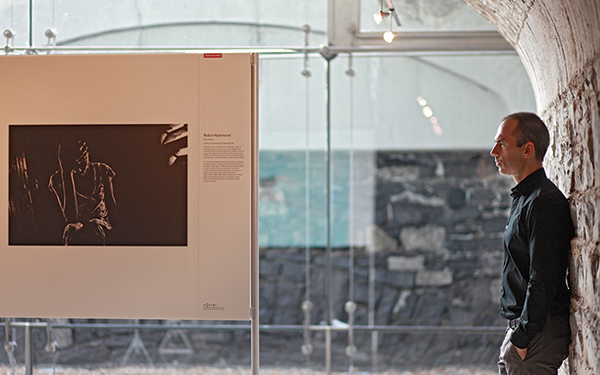
Pictured: Robin Hammond with one of his photographs. Photo by Maria Shields O’Kelly.
“The Windows to the World” is the description by Erik de Kruijf, from World Press about the images displayed at the planet’s most prestigious photo contest, which visited Dublin at the CHQ building on the Irish leg of its world tour.
Spanning almost six decades, the world press foundation, which started as a local contest in Amsterdam has now grown into the biggest photojournalism contest with almost 100,000 images entered and a professional judging panel representing a cross section of the world community.
Speaking at the launch, curator Eamon Kennedy said, “I see this not just as an exhibition of photography but as an exhibition of journalism. We visit 100 cities around the world and wanted to use Dublin as a location with a positive social impact. Quality journalism is vitally important to a decent society.”
Winning images from 10 different categories are displayed, including Sports, Nature and Current Affairs. The World Press Photo of the Year is selected from this group, and this year’s coveted winner is The Signal by John Stanmeyer, depicting a group of migrants on the shore of Djibouti City, arms outstretched in efforts to reach relatives by phone, obtaining a cheaper signal from this popular point.
“Each year at this stage of the contest the potential winner is subjected to much scrutiny and debate, but this is the first year that I have seen relatively no criticism of the final selection,” said de Kruijf. Apart from being a beautiful, eerily haunting image, it is thought that its appeal lies in the fact that it connects to the Western psyche. “The migrants are not portrayed as victims, but as people just like you and me trying to get in touch with loved ones.”
Debate is raised on ethical issues each year with subjects like domestic violence, bomb making and nudity among the talking points this year. There have been requests to omit particular pictures for political/religious reasons on occasions, but the exhibition appears on an all-or-nothing basis. De Kruijf said, “Sometimes an image is picked that means an instant ban from certain countries. A single breast means that entire countries will be omitted from our travels. We have come to call it the boob alarm. Yet single images will not be omitted.
Journalism is important, but freedom of speech is equally important.”
“We have run a human rights essay competition where we identify some of these photos and ask students to speak to them from a human rights angle, with the winner receiving a top scholarship from Queen’s University.” Mohsen Al Attar from Queens University Belfast told NewsFour. “We are excited to partner World Press for this exhibition and also to sponsor the show in Belfast in November. Education is about much more than books and texts, it’s about diversity and engaging with experiences that are otherwise foreign to us. This exhibition is a powerful learning tool.”
Newsfour spoke to human rights photographer Robin Hammond, one of this year’s winners. “I am glad to be back in Dublin for the show and always feel at home here. Maybe it’s because it’s an island country, just like New Zealand. I have been taking pictures for 15 years now, and this is my 15th year to enter the contest, making my first win even more sweet. I wanted to shine a light on an issue that is not talked about in African countries in crisis. I think it is because there is still a lot of stigma attached to the problem, despite the fact that one in four people have mental health issues. That is what World Press are good at, shining a light on dark places.”
De Kruijf told us “I feel honored. It’s not just about stunning images. It’s about access to information. We can sometimes take it for granted that we are able to view these images. Because it’s written, because it’s in a picture, doesn’t mean it’s true. We need to think for ourselves. It really is a privilege.”
For more information on World Press, teacher’s packs, and gallery of images see worldpressphoto.org/exhibition
By Maria Shields O’Kelly

